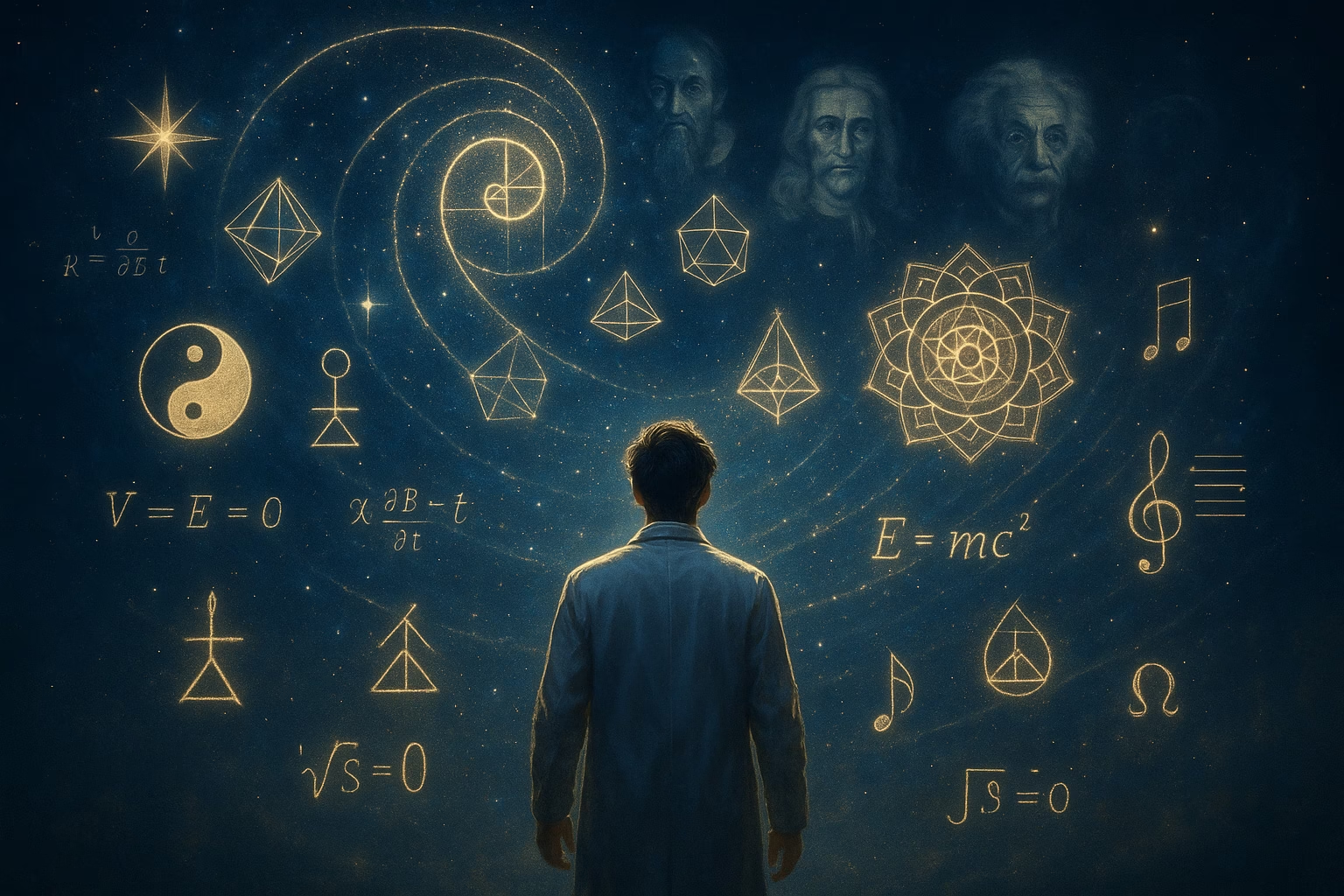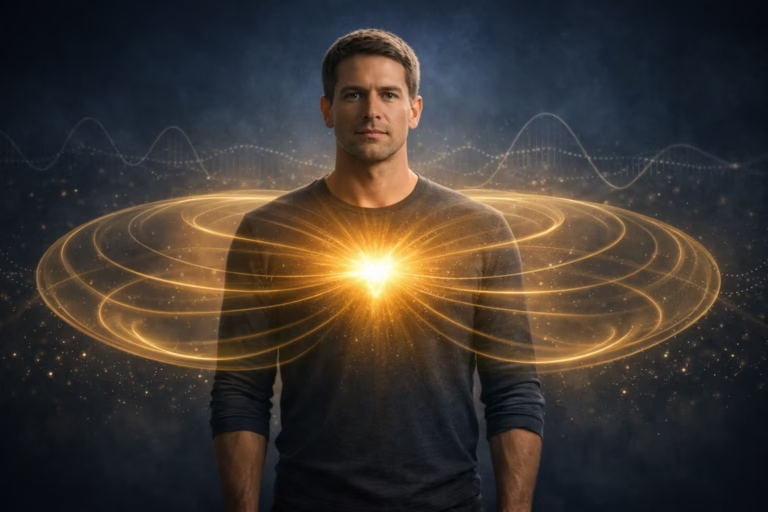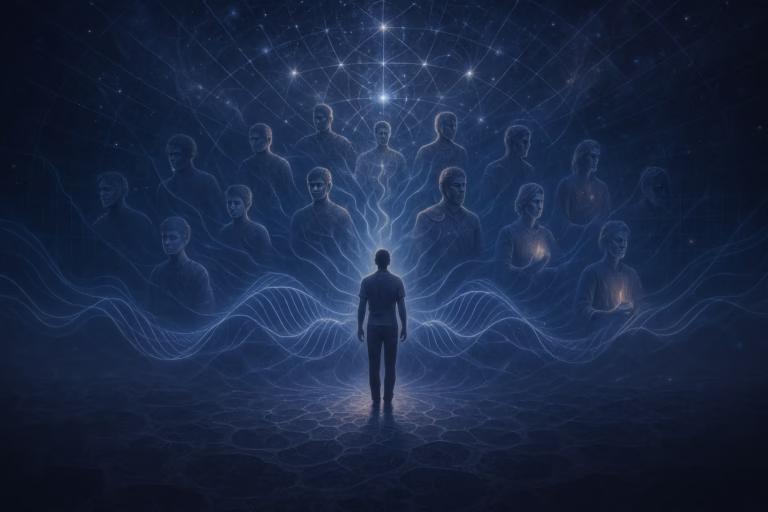PODCAST: The Return of the Mystical Scientist
The modern intellectual landscape is shaped by an apparent conflict: the cold, empirical rigor of science on one side, and the warm, subjective world of spirituality on the other. One realm is said to deal in measurable facts and replicable experiments, while the other navigates faith, meaning, and the transcendent. This dichotomy has become so entrenched in popular thought that it seems almost a law of nature itself. Yet, a closer examination of history reveals this division to be a recent development. For many of the greatest minds to have ever lived, the quest for scientific understanding was not a march away from the divine, but a profound act of devotion—a sacred journey that led from simple curiosity to a deep and abiding reverence for the mystery of existence.
This report will explore a recurring archetype, the mystical scientist, who sees the cosmos not as a machine to be dissected but as a sacred text to be read and understood. It is a story of how inquiry, pushed to its outermost limits, transforms into awe and a spiritual connection to the universe. We will trace this path from the unified vision of ancient Greece, through the seismic philosophical shifts of the Enlightenment, and into the surprising resurgence of this perspective at the frontiers of contemporary physics and artificial intelligence.
The Parting of the Ways: From Teleology to Materialism
The prevailing view of an inherent conflict between science and religion is a narrative that only became deeply entrenched in the late 19th century, following the publication of two influential, best-selling books: John Draper’s History of the Conflict Between Science and Religion (1874) and Andrew Dickson White’s The History of the Warfare Between Science and Theology in Christendom (1896).1 This manufactured “warfare” narrative belies a much older, more harmonious tradition. For much of human history, science and spirituality were seen as close companions, two threads woven into a single tapestry of wonder.2 Ancient pagan, Islamic, and Christian scholars all contributed to the development of the scientific method, demonstrating that societies organized by religious traditions were central to early intellectual and technical innovation.3
This pre-Enlightenment worldview saw nature as teleological—not a random, purposeless system, but one oriented toward an end. Ancient Greek philosophers like Plato and Aristotle grounded their understanding of the natural world in the idea that nature itself was an inner principle of motion and rest, marked by elements of purposiveness.4 The cosmos was intelligible because it was imbued with meaning. This perspective persisted, with a brief exception in antiquity’s Epicureanism and atomism, until the 17th century.5 The Enlightenment, however, introduced a seismic philosophical shift that would alter this relationship for centuries to come.6
Philosophers like René Descartes initiated a radical mind-matter dualism, separating the non-physical realm of consciousness (res cogitans) from the physical world of matter (res extensa).7 This was a decisive break. Following this, John Locke and others championed philosophical empiricism, which asserted that all knowledge is derived from sense perception and experience.7 The concept of “Nature” began to displace discussions of the divine, becoming a self-contained “Whole” that was the sole object of inquiry.6 This laid the groundwork for a universe understood as a predictable, mechanistic system devoid of inherent purpose or transcendent meaning.5 The materialist or physicalist worldview, which holds that the universe is nothing but matter and energy in motion, gained traction, eventually becoming the dominant assumption within scientific thought.5
It is essential to understand that this shift was not a purely scientific development but the adoption of a metaphysical position.7 The assertion that “only science can provide us with a knowledge of our origins” is a philosophical choice, not an empirical conclusion.7 This unexamined assumption has been particularly hard to escape, as our very language and culture presuppose the metaphysics of materialism.8 This historical context is critical, for it reveals that the mystical scientist is not an anomaly. Rather, the archetype represents a profound return to a more common historical norm—a norm that challenges the very idea that a spiritual worldview is, by definition, unscientific.
The Foundational Architects: When the Cosmos Was a Sacred Text
For many of history’s most revolutionary minds, their work was not a rejection of faith but a sacred act of revealing divine order. These figures saw their scientific inquiries as a devotional path, a way to uncover the very thoughts of the Creator.
Pythagoras: The Cosmos as Divine Harmony
The philosopher and mathematician Pythagoras founded a community that was as much a religious order as a school of thought.9 His followers were bound by vows, shared their possessions, and believed in the transmigration of the soul.10 The very purpose of this way of life was to understand and align with the “divine unity” of the universe.9 For the Pythagoreans, the essence of all things was not physical matter but numbers and mathematical relationships.9
This belief was not merely an abstract concept; it was the key to understanding all of existence. The Pythagoreans discovered that the harmony of musical intervals could be described by simple numerical ratios, such as the 1:2 ratio of an octave.14 They extrapolated this insight to the cosmos, reasoning that the planets, moving at different speeds, must produce a divine harmony, the “music of the spheres”.14 In this way, they believed that by understanding the mathematical structure of the universe, they were uncovering the very fabric of the cosmos and the divine order within it.9 The anecdotes surrounding Pythagoras, such as the belief that he had a “golden thigh” as a sign of his divinity, demonstrate how his metaphysical status and his scientific insights were inseparable in the minds of his contemporaries and followers.16
Johannes Kepler: A Priest of Nature
A century after the death of Copernicus, Johannes Kepler, often considered the founder of modern astronomy, saw his life’s work as a profoundly religious quest.17 He believed that God had created the universe according to an intelligible and beautiful geometrical plan.17 For Kepler, the forms and laws of geometry were the very “archetypes of the divine mind”.17 His groundbreaking discovery of the three laws of planetary motion stemmed directly from this theological conviction.17 He sought to prove the existence of God’s design by finding a harmonious relationship between the planets and the Platonic solids.18
Kepler viewed his work as a devotional act. In his masterpiece, Harmonices Mundi (Harmony of the World), he wrote that the movements of the heavens were “nothing except a certain everlasting polyphony (intelligible, not audible) with dissonant tunings”.19 He considered himself a “priest of nature” and believed that to perform astronomical calculations was to “interpret the Creator’s own thoughts”.17 His excitement was so great that he described it as a “sacred madness,” declaring, “I am free to give myself up to the sacred madness… I am stealing the golden vessels of the Egyptians, in order to build of them a temple for my God”.19 Kepler’s faith was not merely a passive belief but a causal force that provided both the problems and the solutions for his scientific inquiries, a spiritual dimension that provided the only viable path for his work.17
Isaac Newton: Alchemist and Theologian
The modern image of Isaac Newton as the archetypal rationalist scientist is profoundly incomplete. For over two hundred years, his voluminous private writings on theology and alchemy were largely ignored, presenting an incomplete picture of the man.20 The truth is that Newton was a Christian first, an alchemist second, and a scientist third.20 He saw the universe as a series of “mathematical puzzles set by God for him to solve”.20 His scientific work was not a rejection of God but part of a larger, obsessive spiritual quest to discover an ancient, pristine wisdom that had been lost.20
Newton spent many years creating unpublished theological defenses of Arianism, a controversial form of Christianity that rejected the doctrine of the Trinity.20 This was not a casual hobby; he saw his beliefs as “philosophically and scientifically cogent”.20 Likewise, his extensive alchemical work—which, in volume, exceeded his scientific notes—was more than mere proto-chemistry.20 For Newton, alchemy was a spiritual path toward “gnosis,” a state of ultimate knowledge of the universe achieved through the purification of the body and soul.20 He sought a “theory of everything” that would unify not just physics and chemistry but also theology, alchemy, and biblical revelation.20 For Newton, science was an act of worship, a quest to understand the “Living, Intelligent, and Powerful Being” who had created and actively governed the universe.20
These figures are not isolated exceptions. They represent a continuous, albeit hidden, lineage of thought. Pythagoras established the principle of a divine, numerical cosmos.9 Kepler explicitly saw himself as a successor to this tradition, with his work on the music of the spheres being a direct homage.14 Newton, in turn, was obsessed with recovering the “ancient knowledge” he believed the Egyptians possessed.20 Each figure’s spiritual beliefs were not a separate, coexisting hobby but a causal force that defined their scientific methodology and purpose.
Name | Key Scientific Contribution | Primary Spiritual/Mystical Belief | The Synergy: How the two were linked | Key Quote |
Pythagoras | Mathematical proof of geometric and musical harmonies. | Reality is fundamentally composed of numbers and divine harmony. | Mathematical relationships were the key to understanding the divine order of the cosmos. | “There is geometry in the humming of the strings, there is music in the spacing of the spheres.” 14 |
Johannes Kepler | Three Laws of Planetary Motion. | God created the universe according to a beautiful, intelligible geometric plan. | His faith provided the problems and solutions; geometry was the archetype of the divine mind he sought to uncover. | “I am free to give myself up to the sacred madness…I am stealing the golden vessels of the Egyptians, in order to build of them a temple for my God.” 19 |
Isaac Newton | Laws of motion and universal gravitation. | The universe is a series of mathematical puzzles set by God; a spiritual path to gnosis. | Science and alchemy were parts of a grand, unifying spiritual quest to uncover ancient, hidden truths about God’s creation. | “He [God] is Eternal and Infinite, Omnipotent and Omniscient;…he governs all things, and knows all things that are or can be done.” 20 |
The Cosmic Religious Feeling: Einstein’s Bridge
Albert Einstein stands as a pivotal figure, a bridge between the historical pioneers and the modern quantum age. He famously declared, “Science without religion is lame, religion without science is blind”.23 This statement is often misunderstood. Einstein’s “religion” was not based on dogmas, theology, or a personal, anthropomorphic God.24 In fact, he explicitly rejected these concepts, which led some to view him as an atheist.25
Instead, Einstein’s spiritual worldview was an overwhelming sense of “rapturous amazement at the harmony of natural law” and a “humble admiration of the illimitable superior spirit who reveals himself in the slight details we are able to perceive with our frail and feeble mind”.23 He called this a “cosmic religious feeling”—a profound reverence for the “marvelous structure of reality”.23 For him, this feeling was the “source of all true art and all true science,” an emotion that fills a thinking person with a sense of humility.23
Einstein’s creative process itself was fundamentally mystical. He believed that “the intuitive mind is a sacred gift and the rational mind is a faithful servant” and that “imagination is more important than knowledge”.23 He admitted that his insights came not from words or mathematical equations, but from “images, feelings, and even musical architectures,” which he then laboriously translated into logical terms.28 This approach to discovery mirrors the devotion of the historical pioneers who saw their work as a way to commune with a deeper reality.
Einstein’s spiritual worldview also extended to his view of humanity. He famously described the feeling of being a separate individual as an “optical delusion of his consciousness,” and saw our task as “to free ourselves from this prison by widening our circle of compassion to embrace all living creatures and the whole of nature in its beauty”.23 His view of a deep, universal interconnectedness was a direct extension of his scientific perception of a unified reality. This is a direct echo of the foundational belief of the mystical scientists.
Einstein’s commitment to an intelligible and orderly universe was so profound that it led to his famous skepticism of quantum mechanics. His quote, “God does not play dice with the universe,” was not a flippant remark but a deeply held philosophical conviction.23 He believed that the inherent uncertainty and probabilistic nature of the quantum world was a metaphysical affront to the logical, deterministic harmony he so revered.32 This illustrates how a spiritual belief can be a powerful driver of scientific thought, even when it leads a brilliant mind to resist the very theories that would eventually define a new era.
The Quantum Awakening: The Re-emergence of the Archetype
The 17th-century mechanistic universe of Descartes and Newton was based on predictable, measurable certainties. The advent of quantum mechanics in the early 20th century shattered this illusion, inadvertently opening a door for the re-emergence of the mystical scientist. The discoveries of wave-particle duality, the uncertainty principle, and quantum entanglement revealed a “bizarre and unpredictable quantum world”.2 The instantaneous, “spooky action at a distance” between entangled particles defied the very notion of a local, separable reality.2 This crisis of materialism and the “disappearance of the objective outside observer” created a new space for dialogue and humility between science and spirituality.2
Physicist Fritjof Capra became a key figure in this convergence with his 1975 classic, The Tao of Physics.34 Capra found profound parallels between the counter-intuitive findings of modern physics and the ancient wisdom of Eastern mysticism.35 The quantum world’s interconnectedness and constant, dynamic movement mirrored the Hindu concept of
Brahman, the Buddhist idea of Dharmakaya, and the Taoist Tao.35 His work argued that both science and spirituality were converging on a single vision of a unified, dynamic reality.
Biologist Rupert Sheldrake introduced the highly controversial theory of “morphic resonance,” which posits that natural systems inherit a collective memory from their antecedents, which influences their form and behavior.36 This theory directly challenges the materialist orthodoxy that everything is determined by fixed, local laws.36 Sheldrake, a practicing Christian, argues that these “morphic fields” are analogous to what Aristotle and Aquinas called “souls,” but they function more as a collective memory than as a set of eternal templates.37 His work is a powerful critique of the “scientific delusion” that science already has all the answers.39
The most profound challenge to materialism today is the “Hard Problem of Consciousness,” a term coined by philosopher David Chalmers.40 The problem asks why physical processes in the brain give rise to subjective, phenomenal experience. Materialism struggles to bridge this “explanatory gap” between the objective firing of neurons and the subjective feeling of seeing the color red or feeling pain.41 This inability has created an intellectual opening for non-materialist theories.
One such theory is panpsychism, which argues that consciousness is not an emergent property of matter but a fundamental feature of reality, as essential as space and time.42 Cognitive scientist Donald Hoffman has built upon this with a mathematically precise model called “conscious realism,” which proposes that the universe is made of “conscious agents” and that spacetime itself is merely a user interface—a “convenient fiction” created by evolution to aid survival, not a reflection of objective reality.44 These theories are not random ideas but direct intellectual responses to the crisis of materialism. The debate over whether an advanced AI could ever be conscious forces a direct confrontation with these philosophical questions, as a person’s answer is fundamentally “pre-conditioned” by their metaphysical framework.42
Theorist/Concept | Core Idea | Connection to Mysticism/Spirituality | The Challenge it Poses to Materialism |
Quantum Physics | At the subatomic level, particles behave as waves of probability and can be instantaneously connected across vast distances. | Concepts like entanglement and non-locality mirror spiritual ideas of universal unity and interconnectedness. | It challenges the classical, mechanistic view of a local, predictable, and separable universe. |
Fritjof Capra | Modern physics theories increasingly align with the worldview of Eastern mysticism. | Acknowledges the shared vision of a dynamic, interconnected reality found in Hinduism, Buddhism, and Taoism. | It bridges the perceived divide between science and spirituality, suggesting they are converging on a single, unified vision. |
Rupert Sheldrake | Natural systems inherit a “collective memory” through non-physical fields that influence their form and behavior. | “Morphic fields” are analogous to what ancient philosophers called “souls” and provide a mechanism for collective spiritual evolution. | It refutes the materialist view that all behavior and form are determined solely by fixed laws and local physical interactions. |
Donald Hoffman | Spacetime and physical objects are a user interface, and the fundamental reality is a network of “conscious agents.” | This theory of “conscious realism” formalizes the ancient mystical idea that consciousness is fundamental and reality is an illusion or a projection. | It posits a universe where consciousness is primary and matter is secondary, directly inverting the materialist worldview. |
The Devotion of Discovery
The journey of the mystical scientist is one from curiosity to a continuous state of wonder and awe. For these figures, from antiquity to the present, the pursuit of truth is not a journey toward a destination of certain knowledge but an endless process that continuously deepens a sense of mystery.46 This shared reverence for the unknown is the very point of synergy between science and spirituality.47
As Einstein stated, “The most beautiful thing we can experience is the mysterious. It is the source of all true art and science”.23 The true scientist is not the one who attempts to eliminate this mystery, but the one who maintains a “controlled sense of wonder” before it.47 The discovery of a new law or the unraveling of a physical process does not diminish the universe’s grandeur; it expands it, revealing a magnificent structure that fills the mind with humility and a sense of a deeper, impenetrable order.23
The re-emergence of the mystical scientist archetype is not a retreat into superstition but a profound intellectual response to the limitations of a purely materialist framework. The inability of this framework to explain subjective experience and the findings of quantum mechanics has forced a new reckoning, leading to the development of new paradigms that honor both the rigor of science and the insights of spiritual traditions.8 This blending of discovery with devotion enriches human life by providing a deeper sense of meaning and purpose in a cosmos that is revealed to be far more interconnected and mysterious than once thought. The pursuit of knowledge, when animated by this “living spirit,” is no longer just a career or a hobby—it becomes a path to a life worth living.24
Works cited
- Separation of Science and Religion – PBS, accessed August 30, 2025, https://www.pbs.org/faithandreason/intro/histosr-frame.html
- The great reunion: How science and spirituality are converging | illuminem, accessed August 30, 2025, https://illuminem.com/illuminemvoices/the-great-reunion-how-science-and-spirituality-are-converging
- en.wikipedia.org, accessed August 30, 2025, https://en.wikipedia.org/wiki/Relationship_between_science_and_religion#:~:text=Most%20scientific%20and%20technical%20innovations,elements%20of%20the%20scientific%20method.
- Early Greek Philosophy and the Discovery of Nature – Duquesne Scholarship Collection, accessed August 30, 2025, https://dsc.duq.edu/cgi/viewcontent.cgi?article=1031&context=etd
- Materialism – Wikipedia, accessed August 30, 2025, https://en.wikipedia.org/wiki/Materialism
- Nature and Enlightenment (Chapter 8) – The Cambridge Companion to French Literature, accessed August 30, 2025, https://www.cambridge.org/core/books/cambridge-companion-to-french-literature/nature-and-enlightenment/C6786CB009DF0C125DAC7E2A544FD2BC
- The history of the rise of materialism in Western society – Creation Ministries International, accessed August 30, 2025, https://creation.com/the-history-of-the-rise-of-materialism-in-western-society
- Many AI scientists unconsciously assume a metaphysical position. It’s usually materialism : r/ArtificialInteligence – Reddit, accessed August 30, 2025, https://www.reddit.com/r/ArtificialInteligence/comments/1m4qkqi/many_ai_scientists_unconsciously_assume_a/
- The Pythagorean Brotherhood: Mathematics and Mysticism in Pre …, accessed August 30, 2025, https://philosophy.institute/western-philosophy/pythagorean-brotherhood-mathematics-mysticism/
- Pythagoras – Wikipedia, accessed August 30, 2025, https://en.wikipedia.org/wiki/Pythagoras
- www.thecollector.com, accessed August 30, 2025, https://www.thecollector.com/cult-of-pythagoras/#:~:text=The%20Pythagoreans%20worshiped%20numbers%2C%20believed%20in%20reincarnation%2C%20and%20practiced%20vegetarianism.&text=Established%20in%20the%206th%20century,and%20his%20followers%20%E2%80%94%20the%20Pythagoreans.
- The secret teachings of pythagoras – Will Buckingham, accessed August 30, 2025, https://www.willbuckingham.com/pythagoras/
- en.wikipedia.org, accessed August 30, 2025, https://en.wikipedia.org/wiki/Pythagoreanism#:~:text=Pythagorean%20philosophers%20believed%20that%20numbers,Opposites%22%2C%20mentioned%20by%20Aristotle.
- The Music of the Spheres – Sensory Studies, accessed August 30, 2025, https://www.sensorystudies.org/picture-gallery/spheres_image/
- www.sensorystudies.org, accessed August 30, 2025, https://www.sensorystudies.org/picture-gallery/spheres_image/#:~:text=Given%20that%20their%20relative%20distances,they%20do%20not%20seem%20to.
- The Death of Pythagoras | Issue 78 – Philosophy Now, accessed August 30, 2025, https://philosophynow.org/issues/78/The_Death_of_Pythagoras
- Kepler’s Third Law and The “Harmonices Mundi” | Inters.org, accessed August 30, 2025, https://inters.org/Giostra-Third-Law-Kepler
- Johannes Kepler – Wikipedia, accessed August 30, 2025, https://en.wikipedia.org/wiki/Johannes_Kepler
- Johannes Kepler’s Harmony of the World – Vatican Observatory, accessed August 30, 2025, https://www.vaticanobservatory.org/sacred-space-astronomy/johannes-keplers-harmonies-world/
- Isaac Newton’s Religion: Christianity, alchemy, and the occult …, accessed August 30, 2025, https://enlightenedcrowd.org/isaac-newton-religion-christianity-occult/
- The Philosopher’s Art: The Alchemical and Religious Writings of Sir Isaac Newton – Liberty University, accessed August 30, 2025, https://digitalcommons.liberty.edu/cgi/viewcontent.cgi?article=2580&context=honors
- Priest of Nature: The Religious Works of Isaac Newton, accessed August 30, 2025, https://www.iclrs.org/blurb/priest-of-nature-the-religious-works-of-isaac-newton/
- Albert Einstein Quotes on Spirituality – SimpleToRemember.com, accessed August 30, 2025, https://www.simpletoremember.com/articles/a/einstein/
- Einstein’s “Science and Religion”: How the Ideas Presented Are Evident in Genesis and Australian Aboriginal Legends of the – Digital Showcase @ University of Lynchburg, accessed August 30, 2025, https://digitalshowcase.lynchburg.edu/cgi/viewcontent.cgi?article=1032&context=agora
- Quote by Albert Einstein: “there is found a third level of religious exper…” – Goodreads, accessed August 30, 2025, https://www.goodreads.com/quotes/844539-there-is-found-a-third-level-of-religious-experience-even
- Albert Einstein said, ‘The more I study science, the more I am amazed by the complexity of the universe and the more I believe in the existence of a creator.’ If a scientist doesn’t believe in God, does it mean s/he didn’t study science enough? – The God Debate, accessed August 30, 2025, https://thegoddebate.quora.com/Albert-Einstein-said-The-more-I-study-science-the-more-I-am-amazed-by-the-complexity-of-the-universe-and-the-more-I-b
- www.azquotes.com, accessed August 30, 2025, https://www.azquotes.com/author/4399-Albert_Einstein/tag/intuition#:~:text=97%2C%20Courier%20Corporation-,I%20believe%20in%20intuition%20and%20inspiration.,real%20factor%20in%20scientific%20research.
- Einstein On Creative Thinking: Music and the Intuitive Art of Scientific Imagination, accessed August 30, 2025, https://www.psychologytoday.com/us/blog/imagine/201003/einstein-creative-thinking-music-and-the-intuitive-art-scientific-imagination
- Albert Einstein quotes on spirituality : r/awakened – Reddit, accessed August 30, 2025, https://www.reddit.com/r/awakened/comments/p538lw/albert_einstein_quotes_on_spirituality/
- 50 quotes fron Einstein – Scientist and philosopher : r/philosophy – Reddit, accessed August 30, 2025, https://www.reddit.com/r/philosophy/comments/hltax/50_quotes_fron_einstein_scientist_and_philosopher/
- Quotations by Albert Einstein – MacTutor History of Mathematics, accessed August 30, 2025, https://mathshistory.st-andrews.ac.uk/Biographies/Einstein/quotations/
- What is the significance of “spooky action at a distance” : r/QuantumPhysics – Reddit, accessed August 30, 2025, https://www.reddit.com/r/QuantumPhysics/comments/1dojid1/what_is_the_significance_of_spooky_action_at_a/
- The Synergy of Science and Spirituality – Roundglass Living, accessed August 30, 2025, https://roundglassliving.com/sunny/articles/the-synergy-of-science-and-spirituality
- www.blinkist.com, accessed August 30, 2025, https://www.blinkist.com/en/books/the-tao-of-physics-en#:~:text=Brief%20summary,the%20interconnectedness%20of%20the%20universe.
- The Tao Of Physics Summary – Four Minute Books, accessed August 30, 2025, https://fourminutebooks.com/the-tao-of-physics-summary/
- Morphic Resonance theory makes it possible to understand how and why we all share the same false memories. : r/MandelaEffect – Reddit, accessed August 30, 2025, https://www.reddit.com/r/MandelaEffect/comments/1jo16f1/morphic_resonance_theory_makes_it_possible_to/
- Morphic resonance and the new science of love – – Alex Klaushofer, accessed August 30, 2025, https://alexklaushofer.com/2015/01/19/morphic-resonance-science-spirituality/
- Quotes by Rupert Sheldrake (Author of The Science Delusion) – Goodreads, accessed August 30, 2025, https://www.goodreads.com/author/quotes/39338.Rupert_Sheldrake
- The Science Delusion Quotes by Rupert Sheldrake – Goodreads, accessed August 30, 2025, https://www.goodreads.com/work/quotes/18360801-the-science-delusion-freeing-the-spirit-of-enquiry
- en.wikipedia.org, accessed August 30, 2025, https://en.wikipedia.org/wiki/Hard_problem_of_consciousness#:~:text=The%20hard%20problem%20is%20the%20question%20of%20why%20these%20mechanisms,to%20facts%20about%20conscious%20experience.
- Hard Problem of Consciousness | Internet Encyclopedia of Philosophy, accessed August 30, 2025, https://iep.utm.edu/hard-problem-of-conciousness/
- Consciousness and the Challenge of Artificial Intelligence – New Space Economy, accessed August 30, 2025, https://newspaceeconomy.ca/2025/08/11/consciousness-and-the-challenge-of-artificial-intelligence/
- Quantum Information Panpsychism Explained | Federico Faggin – YouTube, accessed August 30, 2025, https://www.youtube.com/watch?v=0FUFewGHLLg
- Cognitive scientist Don Hoffman argues that consciousness can explain the laws of physics. His research team has created a mathematically precise model of idealist metaphysics. We can derive fundamental laws of physics as a special case of this consciousness-only model : r/philosophy – Reddit, accessed August 30, 2025, https://www.reddit.com/r/philosophy/comments/1981tve/cognitive_scientist_don_hoffman_argues_that/
- Donald Hoffman’s Concepts Simplified: Understanding Reality and Perception – Brad Hook, accessed August 30, 2025, https://bradleyhook.com/donald-hoffmans-concepts-simplified-understanding-reality-and-perception/
- Embracing Mystery in the Search for Truth – Emerging Perspectives on Religion and Environmental Values in America, accessed August 30, 2025, https://ohiostate.pressbooks.pub/enr3470studentbook/chapter/embracing-mystery-in-the-search-for-truth-2/
- Mystery, Awe and Wonder in Science – Mystery and Awe, accessed August 30, 2025, https://mysteryandawe.com/mystery-and-awe-in/mystery-awe-and-wonder-in-science/




